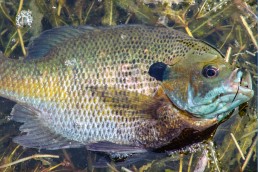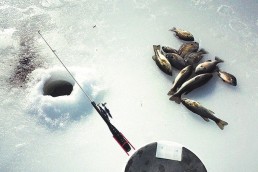Catching Bull Bluegills; 5 Tips You Need To Know!
SHARE THIS POST
Tips to help you catch more bull bluegills
For over six decades I’ve been chasing tasty panfish, especially the larger ones or “bull bluegills.” The term may be a little ambiguous, as what defines a “bull” could mean many things. To some, bull bluegills may be a fish of 8 to 8 1/2 inches, depending upon the fishery; to others it must be a fish of 10 or more inches. A few lucky anglers with access to a private body of water or one with low bluegill fishing pressure might think the term as a fish over 12 inches. But there’s even some disagreement as to what sex the name refers to. Some might consider bull bluegills to mean a big male bull bluegills and others view one (male or a female) over a certain size to be a bull bluegills. I think most people would agree that fish at 11 inches or more are bull bluegills.
Over the years I’ve noticed what I believe to be some behavioral traits that distinguish the big guys from your run-of-the- mill panfish. Along with these observations, I’ve also listed some tips to help you catch bluegill.
1. Fish deep waters in spring and summer
Generally, I believe most people fishing for bluegill fish too shallow. The largest bull bluegills I’ve taken came from a relatively small, central Minnesota lake and where females are between 11 and 11 3/4 inches long. These are platter-size, pre-spawn females with eggs and weigh at least 1 pound. Their beds were in 6 to 7 feet, and not a depth most would associate with spawning fish, especially in a stained water lake.
My largest Indiana bull bluegill came from a small public lake in midsummer. These are all taken on the bottom in the deepest water in this lake at 32 feet, so try fishing deeper than you normally would.
2. Use larger live baits
In the aforementioned trip to Minnesota, my friends and I were anchored in 6 to 7 feet outside an area of bulrushes with a healthy bed of cabbage weeds bordering the rushes. Our bait was a whole nightcrawler on a single hook below a float set at 5-foot depths. My Indiana bull bluegills were taken from deep water while drifting or row-trolling a whole nightcrawler along the bottom on a regular hook and split shot rig. Bluegills are capable of swallowing larger baits than you think. Next time you are on a body of water with a reputation for big bull bluegills, try larger live baits including whole nightcrawlers.
3. Longer rods
Ultra-light combos are great for kids or beginners, but they can actually limit angling effectiveness for the bigger bull bluegills. The biggest advantage of a rod from 8 to 10 feet in length is the increased distance you can get on your casts, especially with lures or jigs at 1/64 and 1/32 ounce. Fishing live bait with a float, you’ll also notice a considerable difference in the length of your casts. If you do some fishing from shore, a longer rod will enable you to reach to deeper water when necessary.
Are you enjoying this post?
You can be among the first to get the latest info on where to go, what to use and how to use it!
In many clear-water natural lakes you may need the extra distance to keep from “spooking” the larger bull bluegills. Theses are very wary and it doesn’t take much to put them off their bite or to send them scurrying out of an area. Another advantage to the longer rod is that it gives the angler more leverage when fighting fish by absorbing more of the fight, taking pressure off your line. This could be critical when using 2- or 4-pound-test in clearer waters.
4. Use fluorocarbon line
Freshwater anglers are fortunate to have fluorocarbon line today. Fluoro actually got its start with saltwater anglers who were looking for a line that was “nearly” invisible while fishing shallow-water bonefish. Several companies manufacture fluorocarbon line.
5. Use a ball-bearing swivel, not a snap swivel
I believe a small swivel (no snap) can be essential with some presentations. When slip bobbing with jigging lures that swim in circles on the fall, like the Rapala Jigging Rap (3/16 ounce), Lindy Rattln’ Flyer Spoon (1/16 ounce), and small spoons like the Kastmaster, I feel that you must use a quality, ball-bearing swivel to prevent problems with line twist. I normally tie the smallest Sampo Ball Bearing Swivel (size 1R with split ring on each end) about 18 to 24 inches above my lure. I also do this when using a cast-and-crank presentation with any of the smaller inline spinners like the Mepps.
Another advantage to using a tiny, quality ball-bearing swivel is obvious when you think about it. What do bluegills normally do toward the end of their fight? They engage in fighting antics, and unlike any other fish that I know of. This will put twist in your line, which could lead to problems.
Now you are ready to go out bull bluegill fishing!
For more on catching bluegill refer to this article.
MWO
SHARE THIS POST
Did you enjoy this post?
You can be among the first to get the latest info on where to go, what to use and how to use it!
Bill Takacs
Bill Takacs of Hammond, Ind., has been writing for MidWest Outdoors regularly since 1975, and has been published in several state, regional and national publications. He fishes for virtually every freshwater fish from panfish to muskies, with the exceptions of sturgeon and alligator gar.




